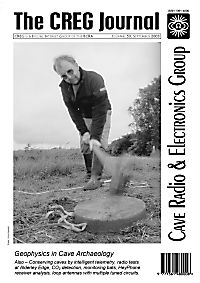
- The most recent issue to be published was 125
- For further information, please see Publishing/Despatch Schedule
- Database last updated on Wed, 03 Apr 2024 16:35:02 +0100
- Online access is currently available for all issues. Some of
the older issues are bit-map scans rather than digital copies.
journal scans.
- Online voting for CREG articles was withdrawn in June 2022. For info see
Voting for CREG articles
Contents of journal 53
September 2003
This page may take a few
seconds to load. Please wait ...
- CREG Journal
(PDF 8.5MB)
  Individual articles may be available below Individual articles may be available below
- Contents
-
- Newssheet
- Why Speech?; CREG AGM; CREG Award Presentation; BCRA AGM; Tunnel Radio; Class B Radio Amateurs Gain HF Privileges.
-
- Intelligent Telemetry Watches Cave Visitors
- The combination of a remote location, and the need to alter dynamically how readings are taken, led to the development of custom hardware and software for a cave-monitoring system. By JA Gázquez, JM Calaforra, N Novas and A Fernández-Cortés.
-
- An Intelligent Telemetry System for Show Caves
- An intelligent telemetry system has been installed in the Covadura system of caves to monitor the effect of visitors on the cave environment. JA Gázquez, JM Calaforra, N Novas, A Fernández-Cortés and J Verger describe the hardware and present some results.
-
- Electronic Detection of Carbon Dioxide
- Concerns have been expressed about the high levels of carbon dioxide found in some caves. Further research is needed, and this would be an ideal application for a cave data logger. But, as David Gibson explains, it is not easy to detect CO2 electronically.
-
- Full-Duplex Radio Using PMR446 Handsets
- The rescue services have expressed a requirement for the 'barrow boy' who accompanies the casualty on a pitch to be in good two-way communication with the hauling team. Richard Rushton investigates a low-cost possibility.
-
- Loop Antennas with Multiple Tuned Circuits
- A simple tuned loop antenna will often have too low a bandwidth. An alternative is not to tune the loop itself, but to follow it with multiple tuned circuits, to achieve a wider bandwidth. Jim Moritz, M0BMU, has experimented with various configurations.
-
- Be Prepared
- Rosy Rabson suggests that our field meetings would be more successful with a bit of planning and preparation.
-
- The Luxeon White LED
- David Gibson reports on LumiLed's new white LED - the 'Luxeon'.
-
- In the Wizard's Footsteps: Cave Radio at Alderley Edge
- In a change from our typical venues, CREG held a mini field meet in the copper mines of Alderley Edge. Mike Bedford describes the weekend's activities and comments on how the performance of cave radios in sandstone differed from that observed in limestone.
-
- HeyPhone Performance under Strong Signal Conditions
- In his final year project at Leeds University, electronic engineering student Dave Clark studied how the HeyPhone performed under strong signal conditions. Here Robin Gape reviews his report.
-
- Geophysics in Cave Archaeology
- Seismic surveying might not have reaped benefits in finding new caves but it has been pressed into service for cave-related archaeological work. Mike Bedford reports.
-
- Bulb Firer: Progress Report
- David Gibson reports on the progress of his Bulb Firer and other cave photography projects, and suggests an interim solution.
-
- Signal-Strength Measurement at LF
- John Rabson has used a variety of receivers over the years, from simple to very complex. Here he describes the various approaches, including his latest configuration, which is based on the Sony 2001D.
-
- Digital Methods of Viewing 3D Images
- Traditionally, preparing photographic stereo pairs for viewing in 3D has involved darkroom techniques. Now digital methods permit anyone with a PC to view three-dimensional photography. Mike Bedford looks at the various methods available.
-
- What Turns on Bats?: Data Logging at Agen Allwedd
- Stuart France has been using ultrasonic detectors and data loggers to monitor the activity of bats in a Welsh cave. Here he presents his results and attempts to rationalise the correlation between outside temperature and bat movements.
-
- Practical Measurements of Earth-Loop Impedance
- John Hey reports on his measurements of earth-loop impedance at different sites, where he found a range from 3 to 5000 ohms, and discusses how this can be accommodated.
-
- Other items
- Web Watch, Letters to the Editor, Diary Dates.
-

|

View Contents:

BCRA is a UK registered charity and is a constituent body of
the British Caving Association,
undertaking charitable activities on behalf of the BCA.
BCRA publishes a range of periodicals and books.
Click here for further information.
|
Searching
To Search our pages using Google, type a search
string in the box at the top of the page and hit your Return key
You can also search our publications catalogue at the British Caving Library
The CREG Journal Search Engine is a new, powerful search engine which will, sometime, be extended
to cover Cave & Karst Science. We have a keyword search facility on our Cave Science Indexes pages but this may be rather out-of-date.
|
For staff use: Link to Database
Show/Hide
download figures next to each item (if available and non-zero; you might need to refresh page first). Counters last
reset on Thu 03-Jan-2019 17:29:28 +00:00. The figures are non-unique
click-throughs.
|








